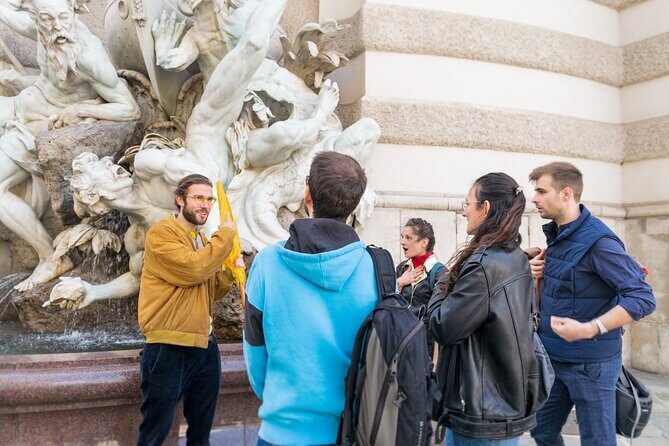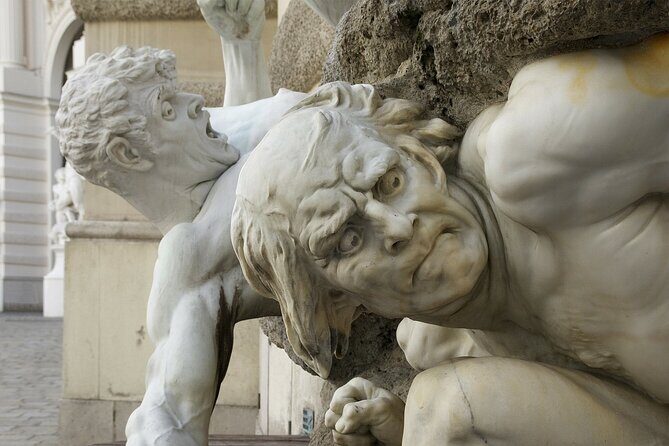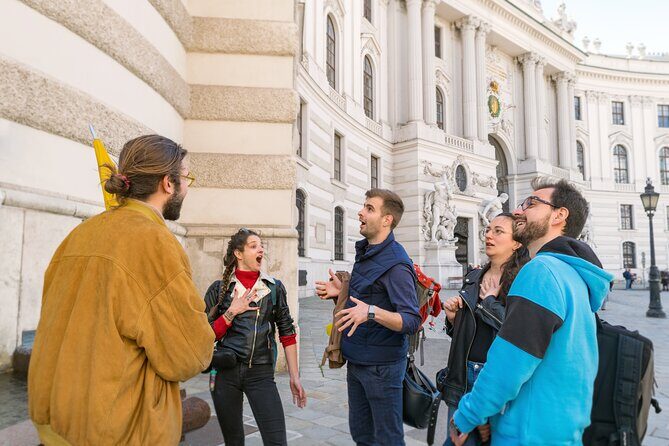Discover Vienna’s Dark Secrets: Terrible Crimes and Hidden Stories in the Inner City
This 2-hour walking tour in Vienna offers a fascinating glimpse into the city’s darker past, from monk dungeons to serial killers and espionage. Led by an engaging guide, you’ll visit intriguing spots such as the Capuchin monastery, Palais Bathory, and the former site of infamous murders. With a price of just $45.12, it’s a surprisingly affordable way to feed your curiosity about Vienna’s secret history.
What we love about this experience is how the guide brings these stories to life through vivid storytelling and little-known details, like the monastery dungeon’s absurd punishments or the intricate details of spy scandals. The inclusion of a complimentary smartphone audio guide makes it easy to follow along and revisit the tales later.
One potential drawback to consider is that this tour is quite intense in content; some stories are gruesome and might not be suitable for sensitive travelers. Also, since the focus is on lesser-known historical crimes, it’s best suited for those who already have a basic understanding of Vienna’s main sights and are eager to explore its shady corners.
This tour is perfect for history buffs, true crime fans, and curious travelers who want to see Vienna from a different, more mysterious perspective. It’s especially recommended if you enjoy stories that aren’t found in typical guidebooks and like a bit of theatrical storytelling combined with rich history.
Key Points
- Unique focus on Vienna’s criminal history and secret stories
- Includes a smartphone audio guide for easy listening and later review
- Visit hidden landmarks not found in most tourist guides
- Small-group setting enhances personal storytelling and interaction
- Cost-effective at just over $45 for two hours of engaging history
- Designed for those interested in dark history, true crime, and Vienna’s lesser-known stories
Uncovering Vienna’s Darker Past: A Comprehensive Walkthrough

For broader city exploration in Vienna, we've covered these other tours
An Introduction to the Tour’s Unique Appeal
We often think of Vienna as a city of grand palaces, classical music, and elegant cafés. But beneath its polished surface lies a storybook of secrets, crimes, and shadowy figures. This tour takes you off the standard tourist trail, into the alleyways and corners where history’s grim tales are hidden. For just over $45, you get approximately two hours of storytelling that reveals the alleyways where monks once imprisoned dissenters, a famous actress’s tragic brush with murder, and the city’s chilling episodes of political violence.
What Sets This Tour Apart
Unlike many city walks that focus on architecture or famous landmarks, this experience zeroes in on the dark side of Vienna. It’s a compact, well-paced exploration of the city’s less glamorous, often disturbing, stories—an excellent choice for those who appreciate history with a twist of horror or intrigue.
The Itinerary: A Step-by-Step Journey into Vienna’s Secrets
Stop 1: Capuchin Monastery and its Dungeon
Our journey begins at the Capuchin monastery, where guide Martin (we’ll call him) recounts the discovery of a centuries-old dungeon by Father Innocentius. These underground cells, often used to lock up monks for minor infractions—sometimes for decades—are a reminder of how discipline was enforced in Vienna’s past. Martin’s vivid descriptions of monks being confined for absurd reasons, like taking an unauthorized walk, make this stop particularly memorable. The fact that Father Innocentius was later transferred to Lviv for safety adds a layer of intrigue.
What you’ll love: The real-life hidden chambers, and how they reflect the city’s strict religious discipline. It’s a rare peek into the lesser-seen side of monastic life.
Stop 2: Trattnerhof and the Jaroszynski Murder
Next, we move to Trattnerhof, where a scandalous case unfolded involving actress Therese Krones. She was drawn into a murder case that practically destroyed her career. The story revolves around Jaroszynski, a man addicted to gambling and drowning in debt, and rumors of his despair leading to murder.
Insight: This case epitomizes how personal vices and societal pressures intertwined in Vienna’s history, leading to a tragic incident. The tale also hints at how women’s reputations could be fragile, especially when caught in scandal.
What you’ll love: The story’s blend of celebrity, crime, and social commentary, plus the way it showcases Vienna’s entanglement of personal tragedy and public scandal.
Stop 3: Palais Bathory & Elisabeth Bathory
A short walk brings us to the Palais Bathory, infamous as the home of Countess Elisabeth Bathory. Often called the “Blood Countess,” she’s reputed to have murdered over 600 virgins—possibly bathing in their blood to preserve her youth.
Note: Whether she was truly a serial killer or a victim of political intrigue, her legend endures, making this stop both chilling and fascinating. The nearby blood legend provides a vivid, if grisly, story that sticks with you.
What you’ll love: The mix of legend and history—and how myths grow around figures like Bathory—plus the opportunity to see the actual site linked to her.
Stop 4: Demel and the Lucona Affair
At the Demel café, we learn about the infamous Lucona scandal—a conspiracy involving an overinsured cargo ship, insurance fraud, and mass murder. The case, which involved over-insured shipments and a lethal explosion, underscores Vienna’s role as a hub for scandal and intrigue in the 20th century.
Insight: The fact that the conspiracy was planned here, in a famous pastry shop, makes the story both bizarre and compelling. It’s a reminder that Vienna’s history isn’t just about composers, but also criminal masterminds.
Stop 5: Ferstel Palace and Medieval Murders
Moving back into history, we visit the site of Ferstel Palace, once home to a house linked to the most notorious mass murder in medieval Vienna. The killer was impaled after committing five murders, including a 7-year-old. The execution took so long because the executioner was inexperienced—highlighting the brutal justice of the time.
What you’ll love: That this gruesome episode happened in what’s now a bustling part of Vienna, showing how history’s dark chapters are woven into the fabric of modern life.
Stop 6: Hotel Klomser and the Redl Espionage Case
A short walk takes us to the old Hotel Klomser, the location where Colonel Redl’s suicide ended Austria’s most famous espionage scandal. Redl was a spy whose activities nearly toppled Austria-Hungary’s military reputation on the eve of World War I.
Insight: This story reveals how espionage and betrayal shaped the course of history—an excellent example of how Vienna’s secrets impacted world events.
Stop 7: Molker Bastei and Raimund Lewisch’s Murders
Here, we hear about Anna Gaugisch, murdered and dismembered by her boyfriend Raimund Lewisch in 1861. Some of her remains were found in the Danube, others nearby, as Lewisch tried to silence her—highlighting domestic violence and blacksmiths’ dark deeds in 19th-century Vienna.
What you’ll love: The visceral detail of the crime, and how it connects to Vienna’s everyday life of that era.
Stop 8: Am Hof and the 1848 Revolution Violence
At Am Hof, we pause at the site of Theodor Baillet de Latour’s murder during Vienna’s 1848 revolution—a rare political killing that marked the start of a violent uprising. The area’s history of civil unrest reminds us that Vienna’s peaceful appearance hides episodes of upheaval.
Insight: This story exemplifies how political passions could explode into violence, even in a city known for stability.
Stop 9: Hannaken-Brunnen and the Surgeon Who Caused Injuries
The Hannaken fountain depicts a surgeon who intentionally caused injuries to boost his business—an eerie example of medical misconduct. It also hints at the marginal groups, like the Hannaken, who migrated to Vienna seeking work.
What you’ll love: The dark humor behind the fountain’s story, and how it reflects societal undercurrents.
Stop 10: Maria Am Gestade and the Last Death Penalty
At the city wall, we visit the site of the Zahlheim case, which led to Vienna’s last use of the death penalty. It highlights how justice evolved during Joseph II’s reign and how brutal punishments were once commonplace.
Insight: It’s a stark reminder of how legal practices have changed, and why some brutal methods fell out of favor.
Stop 11: Himmelpfortgasse and Thekla Riener’s Tragic Tale
Here, we hear about Thekla Riener, murdered by her jealous husband, an act driven by obsession. The story reflects on how personal jealousy could turn deadly, even in elegant Vienna.
What you’ll love: The intense human drama behind this story, and how it echoes the city’s mix of civility and violence.
Stop 12: St. Stephen’s Cathedral and the Legend of the Bakers
Near the cathedral, a legend claims bakers were dipped into the Danube as punishment for bad baking—an odd but memorable story of medieval discipline. It’s a playful contrast to Vienna’s other darker tales.
Insight: Such legends reveal how stories, whether true or not, shape the city’s lore.
Stop 13: Steffl and the Witch Burnings
At the site of the witch trial that led to Vienna’s only witch burning, we learn about the city’s limited but notable witch persecutions, including the case of Plainacher. It’s a chilling reminder of superstitions and justice of the past.
What you’ll love: The rarity of witch persecutions in Vienna, making this a rare glimpse into its medieval fears.
Stop 14: Himmelpfortgasse and a Love That Ended in Tragedy
Finally, we learn about a nun walled in alive because she refused to part with her lover—a story reminiscent of “Romeo and Juliet” with a local twist. It emphasizes how personal passions could turn deadly.
Insight: These stories remind us that love and violence often intertwine more closely than we like to admit.
Why This Tour Is Worth Your Time and Money
We found this tour to be a richly textured walk through Vienna’s shadowy corners. The stories are well-researched, and the guide’s enthusiasm makes the past come alive. The small-group setting ensures you get plenty of attention and can ask questions. The cost of just over $45 reflects excellent value for a two-hour, in-depth exploration that combines history, legend, and true crime.
The inclusion of a smartphone audio guide is a bonus, allowing you to revisit the tales later or follow along comfortably. The tour’s focus on hidden landmarks and stories not found in guidebooks** means you’re uncovering a side of Vienna few travelers see. It’s a perfect match for history lovers, crime aficionados, or those intrigued by Vienna’s darker chapters.
However, the gruesome content and intense stories may not suit everyone, especially travelers sensitive to violence or gore. The tour moves quickly from site to site, so it’s best for those comfortable with a brisk pace and storytelling that sometimes dips into the macabre.
Overall, we believe this experience adds a layer of depth to your Vienna visit, opening doors to stories of crime, intrigue, and human tragedy that have shaped the city over centuries.
- Alpine Hallstatt Day Trip from Vienna incl. Admont Abbey Visit
- Private Day Tour Trip Salzburg Hallstatt and Melk from Vienna
- Vienna Classical Concert at St. Peters Church
- English Vienna Historic Center Guided Walking Tour
- Wachau Valley Small-Group Tour and Wine Tasting from Vienna
- Vienna Dessert Tour: Homemade Cakes, Strudels & Hidden Caffes
Who Should Consider This Tour?

If you enjoy dark history, true crime stories, and lesser-known legends, this tour is a perfect fit. It’s ideal for adventurous travelers who want to see Vienna through a different lens—beyond the palaces and art museums. It also appeals to anyone interested in history with a gritty or shocking edge, providing a balanced, factual account with lively storytelling.
It’s not suited for families with very young children or travelers looking for a purely light-hearted experience. But for those curious about the city’s hidden past and the stories that lurk in its shadows, this tour offers an engaging, eye-opening journey.
Frequently Asked Questions

Is this tour suitable for all ages?
Most travelers can participate, but due to some gruesome and violent stories, it might not be appropriate for very young children or sensitive individuals.
How long does the tour last?
It lasts approximately 2 hours, covering around 14 stops with detailed stories at each location.
Does the tour include entry fees?
No, all the sites visited are free to enter. The focus is on storytelling and sightseeing.
What should I bring?
Comfortable shoes for walking and perhaps a small notebook or smartphone if you want to take notes or revisit the stories via the audio guide.
Is the tour active or physically demanding?
It involves walking through Vienna’s city center, but it’s generally a moderate pace suitable for most visitors.
How many people will be in the group?
The tour is limited to a maximum of 20 travelers, ensuring a more personal experience.
To sum it up, this tour is a treasure for those who want to see Vienna’s history from a darker, more mysterious side. It’s ideal for curious minds, history buffs, and fans of true crime stories. The stories are well-presented, the price is fair, and the chance to explore hidden sites makes it a worthwhile addition to your Vienna itinerary. If you’re looking for an engaging, slightly macabre adventure that uncovers the city’s shadowy stories, this tour is definitely worth considering.
More City Tours in Vienna
More Tour Reviews in Vienna
- Private Scenic Transfer from Vienna to Munich with 4h of Sightseeing
- Vienna: Private Electro Odltimer Tour with Vegan Schnitzel
- Private Tour of Bratislava from Vienna with a Local Guide
- Mystery Rally Vienna: City of Women
- CITY QUEST VIENNA: uncover the secrets of this city!
- Full-Day Private Trip from Vienna to Budapest
More Vienna experiences we've covered
- 16 Most Highly Rated Workshops & Classes In Vienna
- Vienna’s 16 Best Wine Tours
- 16 Top-Rated Vienna Walking Tours
- 16 Best Tours In Vienna (With Reviews & Prices)
- 16 Top-Rated Vienna Shopping & Market Tours
- 3 Top-Rated Vienna Sailing Experiences
- Our 16 Favorite Vienna Private Driver Services
- 16 Best Photography Experiences In Vienna (With Reviews & Prices)
- The Top 12 Lunch Experiences In Vienna
- Vienna’s 16 Top Historical Tours
- Discover 6 Great Hiking And Trekking Tours In Vienna
- Vienna’s 8 Best Full-Day Tours
